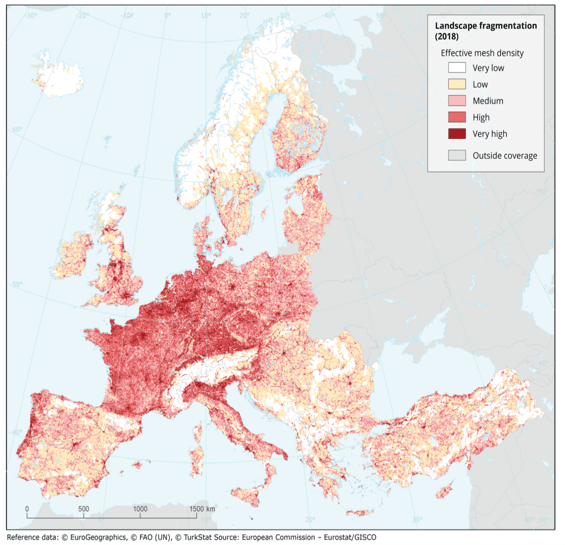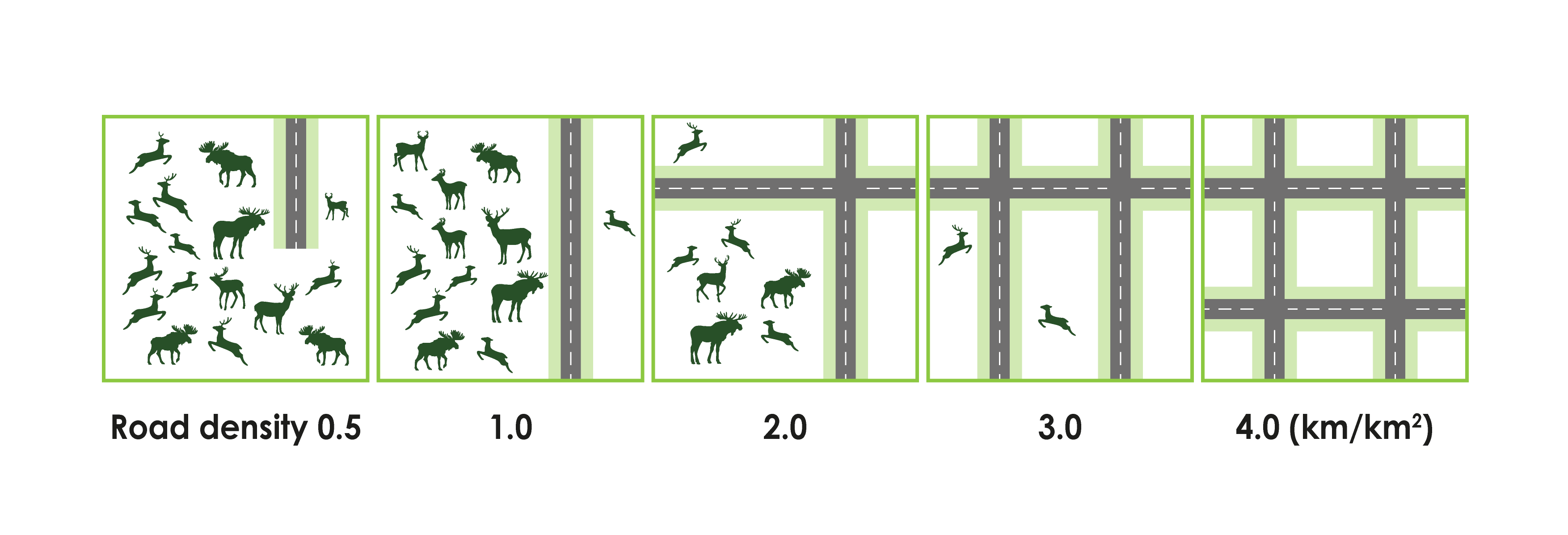The fragmentation of living habitats is recognised as one of the major drivers behind biodiversity loss, worldwide. Wildlife habitats are split, reduced, and isolated from each other by e.g., deforestation, agriculture, urban sprawl, and infrastructure development. Fragmentation typically leads to a reduction in the quality, quantity, and interconnection of suitable habitats. However, ‘habitat’ is a species-oriented concept and hence differs between species. A forest-dwelling species will require a very different habitat than a species adapted to open grassland.
The term ‘landscape’ denotes the human perspective. According to the European Landscape Convention, a landscape is perceived by local people or visitors, and evolves through time as a result of being acted upon by natural forces and human beings. It consists of both natural and cultural land uses and may contain a multitude of different wildlife habitats.
Transport networks not only disrupt and fragment individual habitats directly, but they also contribute to the fragmentation of the entire landscape, with fragments containing different habitats and ecosystems in the meshes of the infrastructure network (Figure 1.4.1). Many regions in Europe are crossed by high densities of infrastructure, i.e., have high to very high relative mesh densities, and hence high degrees of fragmentation.

Landscape fragmentation, as a secondary effect caused by transport infrastructure, is a consequence of the interplay and mutual reinforcement of the primary effects described before. This is different from other sectors, such as intensive forestry or agriculture, that mainly transform and deplete wildlife habitats, while having a larger impact.
The combined effects of habitat loss and isolation can cause non-linear fragmentation effects that reduce the size and viability of local populations and increase their risk of extinction (Figure 1.4.2 and Figure 1.4.3). These effects may not be apparent immediately but may emerge after a long period of exposure to fragmentation pressure that species were able to tolerate. Non-linearity and thresholds in the response of species and ecosystems to fragmentation may make difficult to assess the severity of a given situation. The fragmentation impact may only become noticeable after several generations have passed. Moreover, the responses will vary greatly among species and depend on the characteristics of the landscape and the infrastructure barriers.

To counteract fragmentation, both habitat connectivity and habitat suitability must be restored. This may be achieved by various measures, such as reducing noise and light pollution, limiting traffic, or installing fences combined with wildlife passages. Which option to prioritise depends on many factors including the spatial scale of interest, the density of infrastructure networks, the species involved and the size and spatial configuration of habitat fragments (see Chapter 5 – Solutions to mitigate impacts and benefit nature for specific solutions).
For instance, a single road may create a significant barrier for many wildlife species, but if the habitats on both sides are large enough, populations may persist even if they become genetically divergent over time. However, if the habitats are small and poor, relative to the species’ needs, demographic and genetic differences may appear sooner and species with large area requirements and small population sizes may decline and eventually go locally extinct. As fragmentation progresses, different species are affected differently, and wildlife communities and ecosystems change accordingly. In a dense network of roads, railways, canals, and urban areas, as in many parts of Europe, only the most generalist and adaptable species may survive.
On the other hand, a well-designed and integrated infrastructure network that provides suitable habitat corridors and safe crossing structures may counteract habitat fragmentation by reconnecting otherwise inaccessible habitats (Figure 1.4.3; see Chapter 5 – Solutions to mitigate impacts and benefit nature).
The transport sector has a particular responsibility to minimise the barrier effect of infrastructure and increase its permeability for wildlife. This can be achieved by installing fauna passages and restoring ecological corridors that link habitats. This way, wide-ranging species may be able to maintain large enough home ranges to access food and mates even across a fragmented and patchy landscape. Likewise, local populations may be rescued from extinction by immigration from neighbouring productive areas and the whole meta-population system may remain resilient and thriving.
Mitigating fragmentation is not a simple task that can be solved by a single landscape overpass or even a few wildlife passages. It will require a broad-scaled defragmentation approach to ensure biodiversity to endure at landscape and regional level. Such an approach must also consider the combined effects of land use, urban development, different infrastructure networks and individual species characteristics to develop a strategy for where and when to prioritise mitigation investments.
